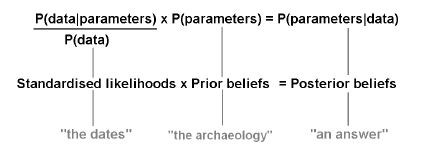Prof. Bayliss (Historic England, University of Stirling) presented an entertaining overview of how the application of Bayesian chronology to archaeological research has the potential to provide specific information and considerably narrow date ranges. She expounded the importance of constraint by using the information already known about a site to provide limits for modelling.
This is because the mathematical model has to incorporate what might seem to be obvious information to us, in order for it to recognise and discount parts of the sample date range that do not fit. For example, putting into the model that a structure’s destruction date must come after it’s start date seems a pointless statement to us, but without this information the model will produce a date range that extends to cover all possibilities.
Prof. Bayliss demonstrated that considerable thought needed to be put into the sampling strategy in order to best fit the research questions and to provide samples that closely match the site stratigraphy. A key emphasis was placed on understanding the taphonomic processes occurring on site as well as utilising the existing relative dating methods (e.g. typologies, seriations). She provided examples of how bayesian chronology can work for different types of sites and sampling, with interesting results.
From pottery sherds, to extensive burial sites, Prof. Bayliss gave examples of how bayesian chronology was applied to deliver tighter date ranges or at the very least, chronological orders for typologies, providing us with an insight into segments of prehistory we have never been able to access in the past.
The application of this type of dating to archaeological data and sites has the real potential to provide reasonably robust, detailed information on activity and population changes over time, including site development and use, and with much smaller time graduations than hundreds or thousands of years. This seminar presented a challenge to archaeologists to reconsider how we perceive activity over time in the prehistoric periods.
Reference:
Bayliss, A. 2009. Rolling out Revolution: Using radiocarbon dating in archaeology. Radiocarbon, 51(1): 123-147.
Written by Matt Knight and Belinda Tibbetts.


